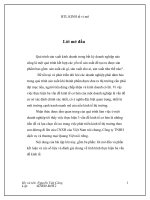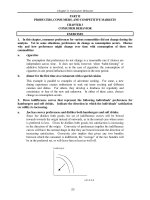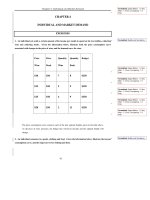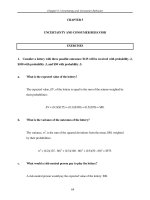Tài liệu Bài tập về Kinh tế vĩ mô bằng tiếng Anh - Chương 3: Hành vi tiêu dùng doc
Bạn đang xem bản rút gọn của tài liệu. Xem và tải ngay bản đầy đủ của tài liệu tại đây (103.67 KB, 14 trang )
Chapter 3: Consumer Behavior
PART II
PRODUCERS, CONSUMERS, AND COMPETITIVE MARKETS
CHAPTER 3
CONSUMER BEHAVIOR
EXERCISES
1. In this chapter, consumer preferences for various commodities did not change during the
analysis. Yet in some situations, preferences do change as consumption occurs. Discuss
why and how preferences might change over time with consumption of these two
commodities:
a. cigarettes
The assumption that preferences do not change is a reasonable one if choices are
independent across time. It does not hold, however, when “habit-forming” or
addictive behavior is involved, as in the case of cigarettes: the consumption of
cigarettes in one period influences their consumption in the next period.
b. dinner for the first time at a restaurant with a special cuisine
This example is parallel to examples of adventure seeking. For some, a new
dining experience creates enthusiasm to seek out more exciting and different
cuisines and dishes. For others, they develop a fondness for regularity and
consistency or fear of the new and unknown. In either of these cases, choices
change as consumption occurs.
2. Draw indifference curves that represent the following individuals’ preferences for
hamburgers and soft drinks. Indicate the direction in which the individuals’ satisfaction
(or utility) is increasing.
a. Joe has convex preferences and dislikes both hamburgers and soft drinks.
Since Joe dislikes both goods, his set of indifference curves will be bowed
inwards towards the origin instead of outwards, as in the normal case where more
is preferred to less. Given he dislikes both goods, his satisfaction is increasing
in the direction of the origin. Convexity of preferences implies his indifference
curves will have the normal shape in that they are bowed towards the direction of
increasing satisfaction. Convexity also implies that given any two bundles
between which the consumer is indifferent, the “average” of the two bundles will
be in the preferred set, or will leave him at least as well off.
hamb urger
soft drin k
23
Chapter 3: Consumer Behavior
b. Jane loves hamburgers and dislikes soft drinks. If she is served a soft drink, she
will pour it down the drain rather than drink it.
Since Jane can freely dispose of the soft drink if it is given to her, she considers it
to be a neutral good. This means she does not care about soft drinks one way or
the other. With hamburgers on the vertical axis, her indifference curves are
horizontal lines. Her satisfaction increases in the upward direction.
hamb urger
soft drin k
c. Bob loves hamburgers and dislikes soft drinks. If he is served a soft drink, he will
drink it to be polite.
Since Bob will drink the soft drink in order to be polite, it can be thought of as a
“bad”. When served another soft drink, he will require more hamburgers at the
same time in order to keep his satisfaction constant. More soft drinks without
more hamburgers will worsen his utility. More hamburgers and fewer soft
drinks will increase his utility.
hamb urger
soft drin k
d. Molly loves hamburgers and soft drinks, but insists on consuming exactly one soft
drink for every two hamburgers that she eats.
Molly wants to consume the two goods in a fixed proportion so her indifference
curves are L-shaped. For any given amount of one good, she gets no extra
satisfaction from having more of the other good. She will only increase her
satisfaction if she has more of both goods.
24
Chapter 3: Consumer Behavior
hamb urger
soft drin k
e. Bill likes hamburgers, but neither likes nor dislikes soft drinks.
Like Jane, Bill considers soft drinks to be a neutral good. Since he does not care
about soft drinks one way or the other we can assume that no matter how many he
has, his utility will be the same. His level of satisfaction depends entirely on
how many hamburgers he has.
hamb urger
soft drin k
f. Mary always gets twice as much satisfaction from an extra hamburger as she does
from an extra soft drink.
How much extra satisfaction Mary gains from an extra hamburger or soft drink
tells us something about the marginal utilities of the two goods, or about her
MRS. If she always receives twice the satisfaction from an extra hamburger then
her marginal utility from consuming an extra hamburger is twice her marginal
utility from consuming an extra soft drink. Her MRS, with hamburgers on the
vertical axis, is 1/2. Her indifference curves are straight lines with a slope of
1/2.
hamb urger
soft drin k
25
Chapter 3: Consumer Behavior
3. If Jane is currently willing to trade 4 movie tickets for 1 basketball ticket then she must
like basketball better than movies. True or false? Explain.
This statement is not necessarily true. If she is always willing to trade 4 movie
tickets for 1 basketball ticket then yes she likes basketball better because she will
always gain the same satisfaction from 4 movie tickets as she does from 1
basketball ticket. However, it could be that she has convex preferences
(diminishing marginal rate of substitution) and is at a bundle where she has a lot
of movie tickets relative to basketball tickets. This would make her willing to
give up more movie tickets to get another basketball ticket. It would not mean
though that she liked basketball better. Her willingness to give up a good would
in this case depend on the quantity of each good in her current basket.
4. Janelle and Brian each plan to spend $20,000 on the styling and gas mileage features of
a new car. They can each choose all styling, all gas mileage, or some combination of the
two. Janelle does not care at all about styling and wants the best gas mileage possible.
Brian likes both equally and wants to spend an equal amount on the two features. Using
indifference curves and budget lines, illustrate the choice that each person will make.
Assume styling is on the vertical axis and gas mileage is on the horizontal axis.
Janelle has indifference curves that are vertical. If the styling is there she will
take it, but she otherwise does not care about it. As her indifference curves
move over to the right, she gains more gas mileage and more satisfaction. She
will spend all $20,000 on gas mileage. Brian has indifference curves that are L-
shaped. He will not spend more on one feature than on the other feature. He
will spend $10,000 on styling and $10,000 on gas mileage.
5. Suppose that Bridget and Erin spend their income on two goods, food (F) and clothing
(C). Bridget’s preferences are represented by the utility function
U(F,C) =10FC
, while
Erin’s preferences are represented by the utility function
U(F,C) = .20F
2
C
2
.
a. On a graph, with food on the horizontal axis and clothing on the vertical axis,
identify the set of points that give Bridget the same level of utility as the bundle
(10,5). Do the same for Erin on a separate graph.
Bridget receives a utility of 10*10*5=500 from this bundle. The indifference
curve is represented by the equation 10FC=500 or FC=50. Some bundles on this
indifference curve are (5,10), (10,5), (25,2), and (2,25). Erin receives a utility of
.2*10*10*5*5=500 from the bundle (10,5). Her indifference curve is
represented by the equation
500=.2F
2
C
2
, or 50=FC. This is the same
indifference curve as Bridget. Both indifference curves have the normal, convex
shape.
b. On the same two graphs, identify the set of bundles that give Bridget and Erin the
same level of utility as the bundle (15,8).
For each person, plug in F=15 and C=8 into their respective utility functions.
For Bridget, this gives her a utility of 1200, so her indifference curve is given by
26
Chapter 3: Consumer Behavior
27
2880=.2
the equation 10FC=1200, or FC=120. Some bundles on this indifference curve
are (12,10), (10,12), (3,40), and (40,3). For Erin, this bundle gives her a utility
of 2880, so her indifference curve is given by the equation
F
2
C
2
P
D
, or
FC=120. This is the same indifference curve as Bridget.
c. Do you think Bridget and Erin have the same preferences or different preferences?
Explain.
They have the same preferences because for any given bundle they have the same
level of utility. This means that they will rank all bundles in the same order.
Note however, that it is not necessary that they receive the same level of utility to
have the same set of preferences. All that is necessary is that they rank the
bundles in the same order.
6. Suppose that Jones and Smith have each decided to allocate $1,000 per year to an
entertainment budget in the form of hockey games or rock concerts. They both like hockey
games and rock concerts and will choose to consume positive quantities of both goods.
However, they differ substantially in their preferences for these two forms of entertainment.
Jones prefers hockey games to rock concerts, while Smith prefers rock concerts to hockey
games.
a. Draw a set of indifference curves for Jones and a second set for Smith.
Given they each like both goods and they will each choose to consume positive
quantities of both goods, we can assume their indifference curves have the normal
convex shape. However since Jones has an overall preference for hockey and
Smith has an overall preference for rock concerts, their two sets of indifference
curves will have different slopes. Suppose that we place rock concerts on the
vertical axis and hockey games on the horizontal axis, Jones will have a larger
MRS than Smith. Jones is willing to give up more rock concerts in exchange for
a hockey game since he prefers hockey games. The indifference curves for
Jones will be steeper.
b. Using the concept of marginal rate of substitution, explain why the two sets of curves
are different from each other.
At any combination of hockey games and rock concerts, Jones is willing to give up
more rock concerts for an additional hockey game, whereas, Smith is willing to give
up fewer rock concerts for an additional hockey game. Since the MRS is a
measure of how many of one good (rock concerts) an individual is willing to give
up for an additional unit of the other good (hockey games), then the MRS, and
hence the slope of the indifference curves, will be different for the two individuals.
7. The price of DVDs (D) is $20 and the price of CDs (C) is $10. Philip has a budget of
$100 to spend on the two goods. Suppose that he has already bought one DVD and one
CD. In addition there are 3 more DVDs and 5 more CDs that he would really like to buy.
a. Given the above prices and income, draw his budget line on a graph with CDs on
the horizontal axis.
His budget line is
D + P C =
C
I
, or 20D+10C=100. If he spends his entire
income on DVD’s he could afford to buy 5. If he spends his entire income on
CD’s he could afford to buy 10.









